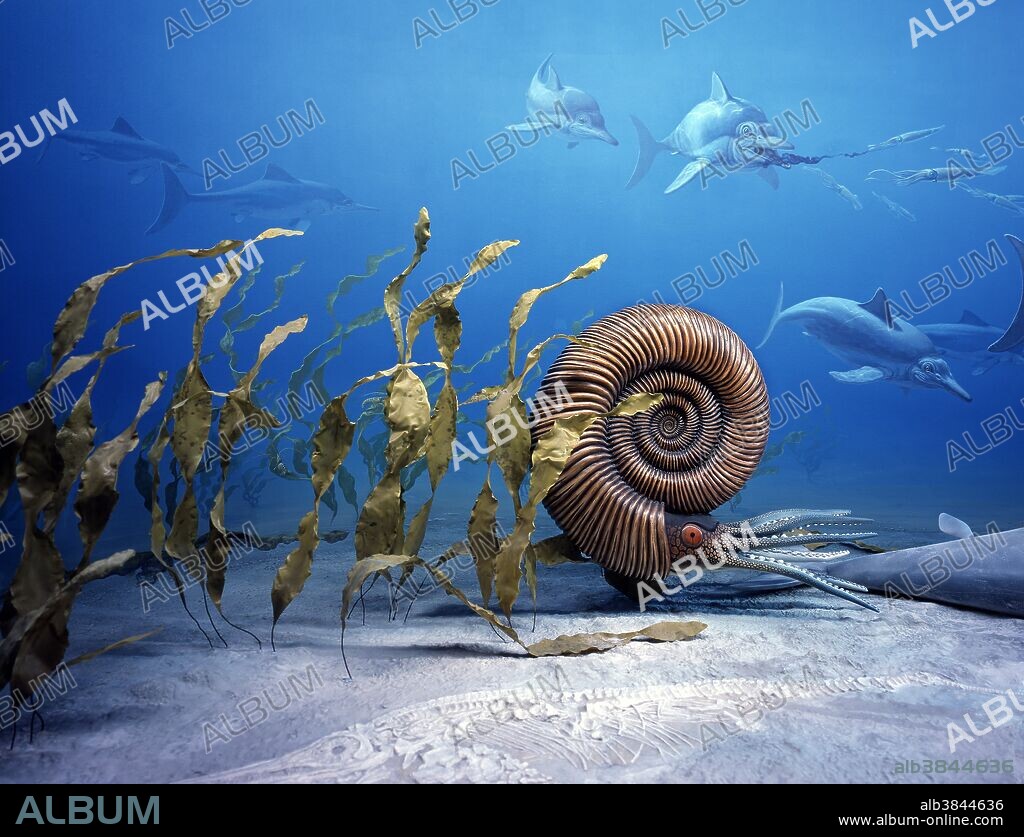alb3844636
Jurassic ocean

|
Add to another lightbox |
|
Add to another lightbox |



Buy this image.
Select the use:

Title:
Jurassic ocean
Caption:
Diorama: Jurassic ocean with ammonite (Titanites anguiformis, based on fossil from Portland, Dorset, England) and ichthyosaurs (Stenopterygius sp. based on fossils from Holzmaden, Germany). Coiled cephalopods, called ammonites, were common in Jurassic seas. They had gas-filled, chambered shells which allowed them to adjust their buoyancy while swimming. Jurassic ammonites over six feet in diameter have been found. Marine reptiles ruled the Jurassic seas. The ichthyosaurs (school shown in background and skeleton in substrate) superficially resembled modern-day dolphins. Their vertical tail fin gave them the fast maneuverability of a fish, and their stiff paddle-like limbs gave them good steering and attitude control. Preserved stomach remains indicate that they fed on fish and cephalopods, like the squid-like belemnites in the upper right corner of the photo. Belemnites had a dense cigar-shaped internal skeleton of solid calcite, often preserved as fossils. The kelp-like algae to the left of the ammonite is hypothetical.
Credit:
Album / Science Source / Chase Studio
Releases:
Model: No - Property: No
Rights questions?
Rights questions?
Image size:
5220 x 3999 px | 59.7 MB
Print size:
44.2 x 33.9 cm | 17.4 x 13.3 in (300 dpi)
Keywords:
ALGA • ALGAE • AMMONITE • AMMONITES • ANIMAL • ANIMALS • BELEMNITE • BELEMNITES • CEPHALOPOD • CEPHALOPODS • CEPHOLOPODA • CUTTLEFISH • DIORAMA • EXTINCT ANIMAL • EXTINCT ANIMALS • EXTINCT • EXTINCTION • FAUNA • FLEET • FOSSIL • FOSSILIZED • FOSSILS • ICHTHYOSAUR • ICHTHYOSAURIDAE • ICHTHYOSAURS • ICHTHYOSAURUS • ILLUSTRATED • ILLUSTRATION • ILLUSTRATIONS • JURASSIC PERIOD • JURASSIC SCENE • JURASSIC SCENES • JURASSIC • MARINE • MESOZOIC ERA • MESOZOIC • MODEL • MODELS • NAVY • OCEAN • OCEANS • PAINTING • PAINTINGS • PREHISTORIC SCENE • PREHISTORIC • PREHISTORY • RECONSTRUCTION • RECONSTRUCTIONS • SEA • SEA. • SEAS • SEASCAPE • SEASCAPES • SEAWEED • STENOPTERYGIUS • SWIM • SWIMMING • SWIMMING. • SWIMS • TITANITES ANGUIFORMES • TITANITES • UNDERWATER SCENE • UNDERWATER SCENES • UNDERWATER SCENIC • UNDERWATER SCENICS • WILDLIFE
 Pinterest
Pinterest Twitter
Twitter Facebook
Facebook Copy link
Copy link Email
Email
